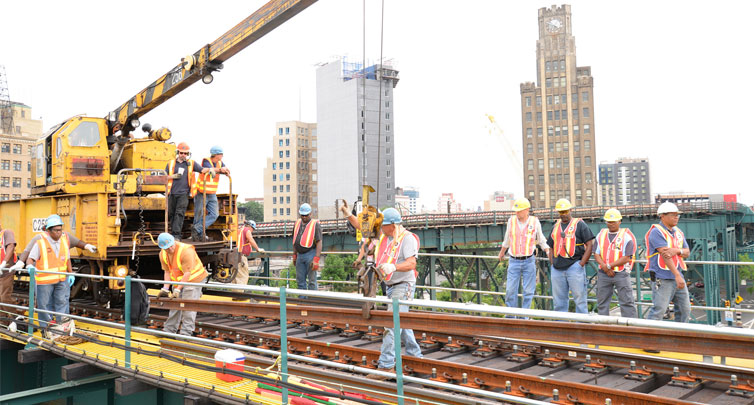Lawmakers Deliver on Pledge to Boost Funding For Transportation in FY2026 State Budget
ALBANY—This year’s grinding state budget battle was near-historic in the making, requiring extensions for 38 days past the April 1 new fiscal year—the latest it has been in 15 years. But what this new budget clearly wasn’t—at $254 billion—was a dollar short in most major categories like education, safety, cost of living adjustments and transportation.
In the weeks leading up to the fiscal plan signed on May 8-9, Gov. Kathy Hochul and the Legislature promised to adequately fund highway, bridge and mass transit needs, and their pledge held. She hailed the FY2026 Enacted Budget that contains the biggest capital investment in New York’s transportation history.
Topline Accomplishments
The enacted budget includes a fully funded Metropolitan Transportation Authority’s (MTA) program of $68.4 billion in FY2025-29 Capital Plan. As part of this funding program, some $6 billion will be allocated to the Long Island Rail Road and Metro-North Railroad, respectively, as well as increase resiliency against flooding and protect the Hudson Line against severe weather.

With widespread support from regional lawmakers to add hundreds of millions of dollars to the FY2026 state budget to fix roads and bridges—and adjust for escalating project costs caused by punishing inflation since 2022—Gov. Kathy Hochul added the promised funding level of $800 million. The increase will help restore the purchasing power for NYSDOT’s core highway and bridge construction projects to address rising construction costs and ensure that current projects remain on track.
The Construction Industry Council of Westchester & Hudson Valley, Inc., applauded the governor and legislators for the significant increase in road repair funding included in the newly adopted state budget, which also adds an extra $50 million for the Consolidated Local Street and Highway Improvement Program known as CHIPS.
CIC Executive Director John Cooney, Jr., said, “In a challenging financial year, it is particularly gratifying that the governor and legislators recognized the need for additional funding that keeps pace with inflation and enables us to engage in a robust road repair program. This significant commitment will allow us to make real progress in improving the safety and reliability of our infrastructure throughout the Hudson Valley.
Mr. Cooney also thanked Senate Majority Leader Andrea Stewart-Cousins and the entire Hudson Valley state legislative delegation for their leadership and unwavering support.
“This landmark investment comes at a critical time for the region, particularly within the NYSDOT Region 8 of the Lower Hudson Valley, which faces the most challenging road conditions in the entire state,” he added. “The increased allocations directly address the dramatic inflationary pressures that have significantly impacted the cost of road projects.”
The adopted budget earmarks a total of $3.4 billion for the CORE program, representing a substantial 37% increase over the previous year. This additional funding will enable the state DOT to complete crucial projects outlined in its current five-year plan, which is now in its fourth year.
The CHIPS program will receive a total of $648 million, an 8.4% increase from the prior year. This boost in funding for local roads will have a tangible impact on communities throughout the seven counties of the Mid-Hudson region. For example, a community like Ossining is projected to see an 8% to 9% increase in state funding for vital local road repairs.
In addition to improving road conditions for residents and businesses, the trade association emphasized that this increased funding will create and sustain vital jobs within the construction industry throughout the region.
FY2025-2026 State Budget
Investing in State and Local Roads and Bridges
The FY26 Enacted Budget includes nearly $7 billion for the fourth year of the record $34.3 billion, five-year NYSDOT Capital Plan. The budget also includes:
- $1.4 billion in each of FY2026 and 2027 to support local roads and bridges;
- $648 million for the Consolidated Local Street and Highway Improvement Program (CHIPS), which represents a $50 million year-to-year increase;
- $140 million for the State Touring Routes Program;
- $100 million for the Pave Our Potholes Program.
- As mentioned, an additional $800 million to restore purchasing power for NYSDOT’s core highway and bridge construction projects to address rising construction costs and ensure that current projects remain on track.
Hudson Valley Rail Service Upgrades
The budget includes a $25-million investment to plan, evaluate and design a set of Hudson Valley rail capital improvements between New York City and Poughkeepsie that aim to increase capacity, reduce delays and shorten the potential travel times by up to 15 minutes each way for certain trips. Another goal is to shorten the “super-express” Metro-North Hudson Line trips from Dutchess County to less than 90 minutes.
Other improvements sought will be projects such as a second track at Spuyten Duyvil in The Bronx, interlocking, signaling and trackwork at Croton Harmon in Westchester and capacity improvements at Poughkeepsie Yard.
In addition, the MTA will execute a signaling redesign near Yonkers and climate resilience investments in the most vulnerable and highest ridership segments of the Hudson Line.
To further enhance transit options west of the Hudson River, the state is committing $1 million to perform a transit analysis of opportunities to expand and maximize the impact of rail service and improve commuter transit to New York City and other key regional destinations.
Investing in Mass Transit
The FY26 Enacted Budget will add more than $1 billion for Upstate, Downstate and special capital projects in other parts of the state. These include:
- $349 million, up $16 million, for Upstate transit systems;
- $589 million, up $37 million, for Downstate transit systems;
- $220 million for non-MTA transit system support in capital funding;
- $26 million in capital appropriations to the Niagara Frontier Transportation Authority (NFTA) for infrastructure and resiliency improvements.
Budget Note: As is customary, budget officials said that the top line number of $254 billion does not include an additional approximately $7 billion to pay off the state’s unemployment insurance debt.
Published: May 15, 2025.
